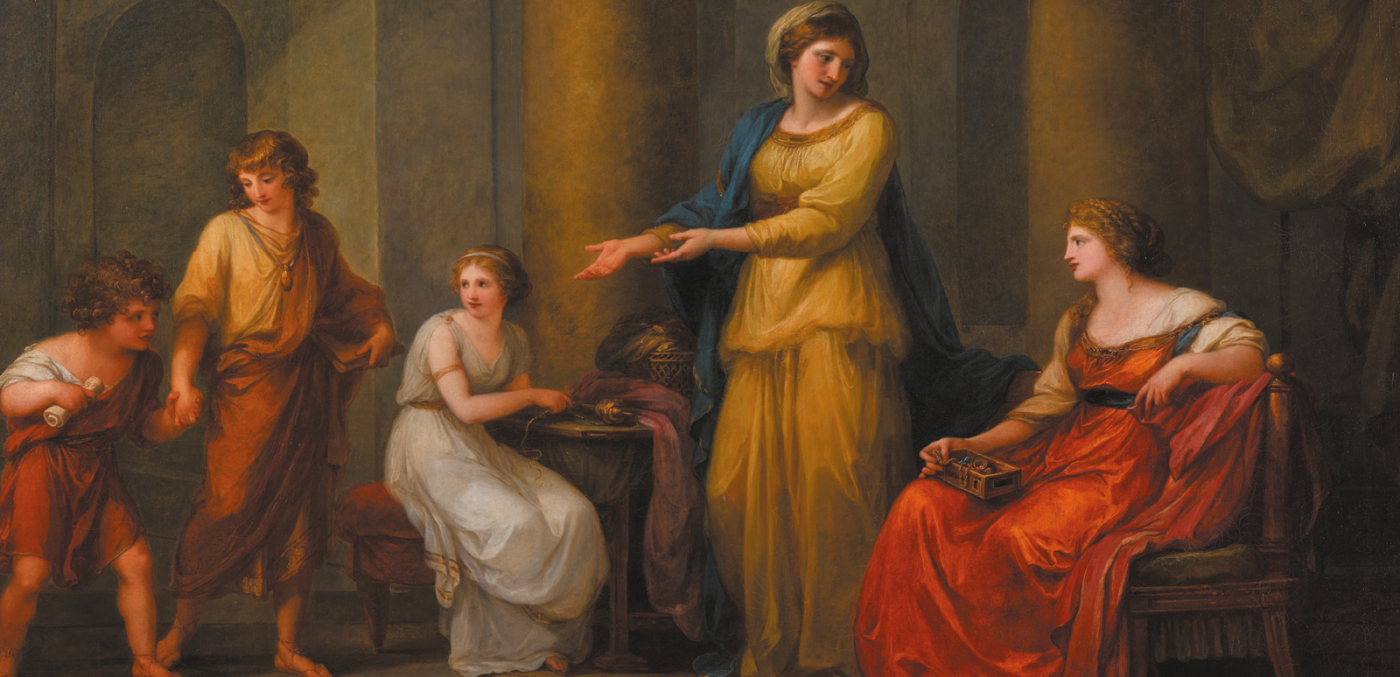Angelica Kauffman – Cornelia, Mother of the Gracchi
Presentation of the painting as part of the Masterpieces at the Castle series
From 8 March 2022
Antechamber
The presentation is included in the Royal Route
This painting by Angelica Kauffman, a prominent Neoclassical artist, is one of the most important canvases of the period and an extremely valuable fruit of the Polish patronage from the times of the First Polish Republic. It was commissioned by Prince Stanisław Poniatowski, the king’s nephew and a world-famous Polish collector of art from the turn of the 18th and 19th century, who in 1788 was revisiting Rome.
The scene was painted based on a description from a collection of ancient didactic stories entitled Facta et dicta memorabilia [Memorable deeds and sayings] by a Roman writer Valerius Maximus. It presents Cornelia, the mother of the Gracchi brothers who would grow to become prominent social and constitutional reformers of the Roman Republic.
„That children are the greatest ornaments to married women, we find written by Pomponius Rufus in his book of Collections, as follows. When a Campanian lady staying at the house of Cornelia, the mother of the Gracchi, showed her her jewels and other ornaments, which were the fairest of any at that time, Cornelia remained talking with her till her children returned from school. "And these," she said when they appeared, "are my ornaments." For he has everything that covets nothing, and much more certainly than he that possesses all things”. (translation by S. Speed (1678))
The meaning of this story highlighting the importance of traditional Roman virtues such as modesty, dedication to one’s family and loving motherhood is very suggestive. All these values are also referred to in the Enlightenment ethics, which Prince Stanisław was keenly interested in from his youth.
The work exemplifies the great change that the European painting had undergone in the 1780s, among others due to the discovery of the Pompeian wall paintings. Moreover, as the equally famous Oath of the Horatii by Jacques-Louis David, the painting serves as an example of republican moral didacticism that draws its themes from ancient exemplary stories.
After studying art in several Italian cities, Angelica Kauffman, a Swiss artist, settled for some time in Rome, where she learned about the latest artistic and ideological trends and met the reformers of the arts themselves, such as Gavin Hamilton and Johann Joachim Winckelmann. In pursuit of her career, in 1766 she decided to move to London, eventually becoming a co-founder and an active artist at the Royal Academy. Having returned to Italy for good in 1782, as one of the few 18th-century female artists she had already become recognised on an international level. Today, she is known as one of the most influential figures of the intellectual elite of the era.
In addition to her excellent portraits commissioned by prominent figures stemming from both sides of the Atlantic Ocean, a special place in her body of work is occupied by the most valued paintings of her time – of historic and mythological scenes. It is in their case that the artist developed her unique, well-thought-out style that drew its strength and originality from paintings depicting ancient themes and, above all, from her own, female experience. Those pieces of art include: Hector taking leave of Andromache (1768, National Trust, Saltram, Devon), The Sorrow of Telemachus (1783, Metropolitan Museum, New York), Pliny the Younger and his Mother at Misenum (1785, Princeton University Art Museum, New Jersey), and a painting that once formed part of the Polish collections – Virgil reading the Aeneid to Augustus and Octavia (1788, Hermitage, Saint Petersburg), commissioned by King Stanisław August and originally exhibited in Warsaw.
The painting of Cornelia, Mother of the Gracchi was purchased for the collections of the Royal Castle in Warsaw in 2021. Its acquisition not only restores this extraordinary work of art to the Polish state, but also enriches the Museum’s collection with yet another painting of the highest world-class quality.
The display is included in The Royal Route
Ticket prices and opening hours>
